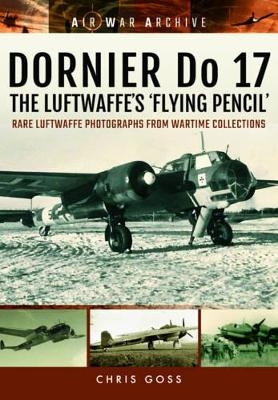
Dornier Do 17 the Luftwaffe's 'Flying Pencil'
Rare Luftwaffe Photographs from Wartime Collections
Seiten
2018
Frontline Books (Verlag)
978-1-84832-471-8 (ISBN)
Frontline Books (Verlag)
978-1-84832-471-8 (ISBN)
With the He 111, the Do 17 formed the backbone of the Luftwaffe's bomber force in the early part of the WW2.
For the first three years of the Second World War, the Dornier Do 17 was the Luftwaffe's principal light bomber. Designed to be fast enough to outrun contemporary fighter aircraft, the Dornier helped to spearhead Germany's Blitzkrieg as Hitler's armies raced through Poland and then France and the Low Countries. Until its withdrawal to secondary duties in 1941, the Dornier Do 17 served in every theatre of war involving German forces. This included the invasion of the Balkans and Greece as well as the battle to capture Crete. After suffering heavy losses at the hands of Fighter Command in the Battle of Britain, the Do 17 was employed in Operation Barbarossa, the invasion of the Soviet Union in 1941. The Do 17 was withdrawn from frontline service later in 1941 but continued to be used by the German Air Force in various roles until the end of the war, including seeing service as a glider tug and in the defence of the Reich in 1944 as a night fighter. In this compilation of unrivalled images collected over many years, and now part of Frontline's new War in the Air series, the widespread deployment of the Dornier Do 17 is portrayed and brought to life.
For the first three years of the Second World War, the Dornier Do 17 was the Luftwaffe's principal light bomber. Designed to be fast enough to outrun contemporary fighter aircraft, the Dornier helped to spearhead Germany's Blitzkrieg as Hitler's armies raced through Poland and then France and the Low Countries. Until its withdrawal to secondary duties in 1941, the Dornier Do 17 served in every theatre of war involving German forces. This included the invasion of the Balkans and Greece as well as the battle to capture Crete. After suffering heavy losses at the hands of Fighter Command in the Battle of Britain, the Do 17 was employed in Operation Barbarossa, the invasion of the Soviet Union in 1941. The Do 17 was withdrawn from frontline service later in 1941 but continued to be used by the German Air Force in various roles until the end of the war, including seeing service as a glider tug and in the defence of the Reich in 1944 as a night fighter. In this compilation of unrivalled images collected over many years, and now part of Frontline's new War in the Air series, the widespread deployment of the Dornier Do 17 is portrayed and brought to life.
Having retired from the RAF with the rank of Wing Commander, CHRIS GOSS is a regular and highly respected contributor to major aviation publications in the UK, France and Germany.
| Erscheinungsdatum | 14.06.2018 |
|---|---|
| Zusatzinfo | Approximately 200 illustrations |
| Verlagsort | Barnsley |
| Sprache | englisch |
| Maße | 189 x 246 mm |
| Themenwelt | Natur / Technik ► Fahrzeuge / Flugzeuge / Schiffe ► Militärfahrzeuge / -flugzeuge / -schiffe |
| Geschichte ► Allgemeine Geschichte ► 1918 bis 1945 | |
| Geisteswissenschaften ► Geschichte ► Regional- / Ländergeschichte | |
| Geschichte ► Teilgebiete der Geschichte ► Militärgeschichte | |
| Sozialwissenschaften ► Politik / Verwaltung | |
| ISBN-10 | 1-84832-471-5 / 1848324715 |
| ISBN-13 | 978-1-84832-471-8 / 9781848324718 |
| Zustand | Neuware |
| Haben Sie eine Frage zum Produkt? |
Mehr entdecken
aus dem Bereich
aus dem Bereich
von der Machtergreifung bis zur Gründung der Vereinten Nationen
Buch | Softcover (2023)
Motorbuch Verlag
CHF 38,90


